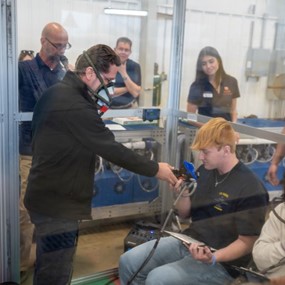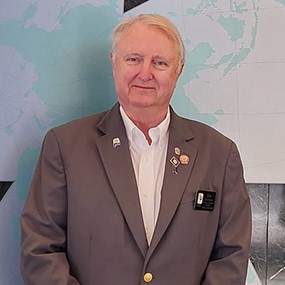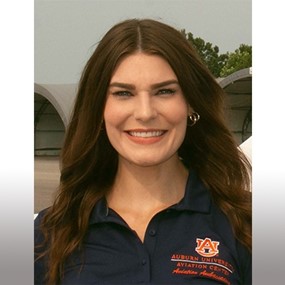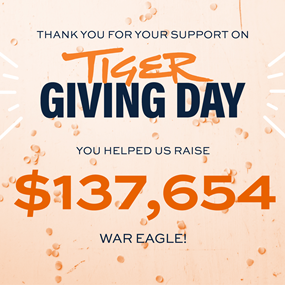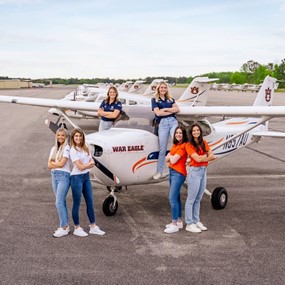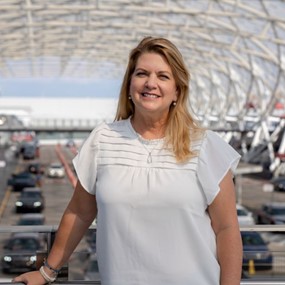TYDKYDK about Diversity in Aviation with Alan Meyer
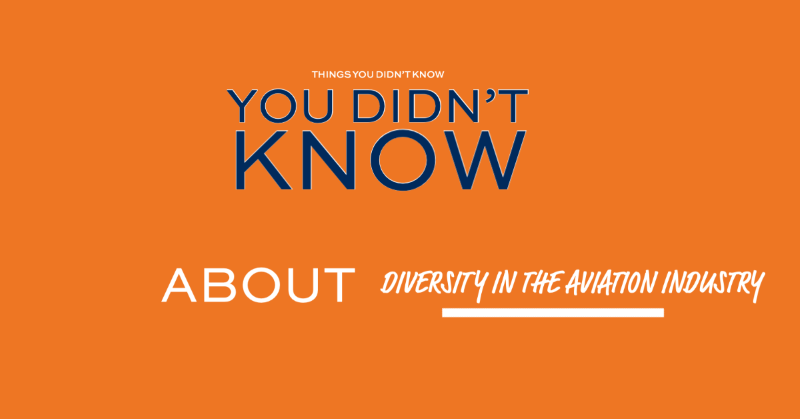
If you look at the websites for each of the major U.S. airlines, you will find on each a statement about their focus on inclusion and diversity. You’ll see statistics and plans for increasing diversity in the flight deck and throughout the company. So how bad is the problem? And, the million-dollar question, how do you fix it? In this episode of the Things You Didn’t Know You Didn’t Know podcast, we take a deep dive into the history, the problem and potential solutions to diversifying the aviation industry.
Transcript
Brandon Etheredge...: If you look at websites for each of the major US airlines, you'll find on each a statement about their focus on inclusion and diversity. You'll see statistics and plans for increasing diversity in the flight deck and throughout the company. So how bad is the problem? And the multimillion-dollar question: how do you fix it? In this episode of the Things You Didn't Know You Didn't Know podcast, we take a deep dive into the history, the problem, and potential solutions to diversifying the aviation industry.
Welcome to another episode of the Things You Didn't Know You Didn't Know podcast. I'm Brandon Etheredge, and I'm incredibly excited to welcome Dr. Alan Meyer to the podcast. He's an associate professor in the Department of History at Auburn University, where he studies the history of technology and aerospace and aviation history. He's also a Verville fellow at the Smithsonian Institute's National Air and Space Museum in Washington, DC. Today we're chatting about his research and his two books on diversity in the aviation industry. Thanks for spending some time with us today.
Dr. Alan Meyer: Thanks for having me.
Brandon Etheredge...: So Dr. Meyer, you have a book out now called Weekend Pilots: Technology, Masculinity, and Private Aviation in Postwar America, and it looks at the history of women in aviation. And another one that you're working on called Flying While Black, that looks at racial integration in the aviation industry. So let's start with kind of the problem that we're talking about here. When we're talking about diversity in aviation, how big of an issue are we dealing with here?
Dr. Alan Meyer: Well, let's start with the issue of women pilots, and let's go back and look at the 1950s and then compare that to today. So in 1958, when the FAA started collecting statistics on male versus female pilots, less than 3% of all civilian pilots in the United States were women. Now, let's be clear, there were no women pilots in the US military at the time and there were no women flying for the airlines. The airlines simply refused to hire women pilots. Now there were a handful of women who flew for a living, but compared to an airline job, these were in relatively low-status, low-pay positions, like flight instruction.
By 1978, the percentage of women pilots had doubled from around 3% up to 6%. Now that's still pretty low considering that women make up about half of our population. But on the other hand, increasing the number of women in the pilot seat from 3% to 6% represents a measurable change. Let's also remember that a lot of other changes took place during those 20 years, between 1958 and 1978. The baby boom generation born following World War II was coming of age, bringing new ideas about the proper roles for men and women in society. Second-wave feminism, better known as the women's liberation movement, really takes off during the 1960s and this continues into the 1970s with a nationwide attempt to pass the equal rights amendment to the United States Constitution.
In 1973, major passenger airlines finally start hiring women pilots. Also in the early 1970s, the Air Force, Navy and Army all start admitting women into military flight schools. So, that's a lot of changes that help account for this increase from 3% to 6%. But then after 1978, that number stops rising. In fact, for the next 40 years from 1978 to 2018, it remains stuck at 6% plus or minus 0.5%. Even today, in 2022, it's still below 10%. And that's a number for all licensed civilian pilots, including those who don't fly for a living. In the workforce, the number of women pilots today is closer to around 5%. So here we are nearly 50 years after the first women pilots were hired to fly for the airlines, and that's also nearly 50 years after the US military starts training women pilots, and yet less than 10% of all pilots in the US are women and only around 5% who fly for a living are women. So that got me wondering, why after 50 years is this number so low?
Brandon Etheredge...: Yeah, that's kind of where I want to dig in on, is why is this such an issue? What is your research uncovered about, despite the improvements we originally saw, why are women not more represented in the flight deck at airlines?
Dr. Alan Meyer: So up to the 1970s, we could maybe just write this low number of women pilots off to a lack of professional opportunity, right? But as I mentioned, starting in the early 1970s, the airlines begin hiring women pilots and the military finally starts admitting women to flight school, so opportunities start to open up. This means that structural barriers are starting to fall, which means maybe there's a cultural component to the continued low number of women. I chose to look at private aviation as a case study for two reasons. First, unless you learn to fly in the military, earning your private pilot's license is the first step towards to becoming an airline pilot. This means private aviation serves as a kind of gateway. You have to pass through it in order to pursue a flying career. The second reason is that private aviation, as we know it today, really has its foundations in World War II. So it turns out that what's going on in private flying is also a reflection on military aviation.
Now, 1940, on the eve of US entry into World War II, there were only 40,000 civilian pilots in the United States. During the war, the US military alone trained over a quarter million pilots, all of them men, to fly fighters and bombers. Another 400,000 college-age men earned their private pilots license in a wartime program called the Civilian Pilot Training Program. And then right after the war, hundreds of thousands of veterans who had not flown during the war used their GI Bill education benefits to earn their private pilots license. As a result, we go in about 10 years from 40,000 civilian pilots in 1940 to over half a million civilian pilots by 1950. And almost all of these new pilots are young men under the age of 30, who had served in the war. And they chose to create and perpetuate a distinctly masculine community in aviation. In fact, they even called it a fraternity of pilots, and the cultural characteristics and values that this fraternity of pilots embraced got passed down to a new younger generation of pilots.
So that leads to our question: why does this matter? Well, it matters because this is the culture you're going to encounter when you walk through the gate at your local airport to sign up for flying lessons, the first step towards a job in the airline. And traditionally, what a prospective student pilot finds when they walk through the airport gate is that, 19 out of 20 pilots that they meet hanging out at the airport in the pilot's lounge were men. And many, not all, but many of these men embraced a culture that defined flying as an inherently guy thing. Today we might call this a bro culture, a series of practices, that on the surface just look like the rituals of bonding and friendship, but deep down are actually practices of inclusion and exclusion, practices that define who's a member of the club and who isn't. And student pilots did not just encounter this attitude in the pilot's lounge, it also shaped the nature of flight instruction.
During World War II, most flight instructors were brand new pilots themselves. They might be good at flying, but they had very little experience instructing. So wartime flight instruction became famous for this adversarial, almost abusive relationship between instructor and student. The basic justification was this: If you can't stand a little verbal abuse in training, how are you going to hold up when the bullets start flying in combat? Well, even the military recognized this approach of yelling and abusing your students did not necessarily produce the best pilots. Instead, it really just succeeded in weeding out people who didn't respond well to this kind of bullying regardless of their actual flying aptitude. But hundreds of thousands of pilots learned to fly this way during the war, and some of them became the flight instructors who taught the GI Bill flight students after the war.
So this model of flight instruction, more like a drill sergeant than a teacher, gets passed down from one generation to the next. Interestingly, you start to see complaints about this, show up in aviation magazines starting in the 1950s, when women are described as being better flight instructors than men. And this is based on a gendered stereotype at the time when most school teachers were women, and women were widely seen as inherently more patient and nurturing than men. But the reason that these discussions start showing up is because the men who are in charge of the aviation industry, that's men who are trying to grow their business, these guys are worried that bullying in the cockpit by flight instructors is driving away potential students. So these kinds of complaints give us a window into the kind of culture that decides who is and who is not supposed to become a pilot.
So that's one example of how this hypermasculine culture weeded out people who didn't fit into a particular stereotype. That is a stereotype that not only assumes pilots were white men, but also a stereotype that assumed or really demanded that pilots should also be tough enough to tolerate this kind of abuse. And it's in this environment where people who don't fit the white male stereotype, so we're talking about women and people of color. People who don't fit this stereotype often found themselves as targets of extra abuse, which they had to overcome in order to prove that they were worthy of joining the ranks of pilots.
Brandon Etheredge...: What I think is interesting about this is that, it isn't just women, like you mentioned, that have an issue here. Your current book project that you're working on called Flying While Black uncovers issues related to the lack of pilots of color in the flight deck. What more can you tell us about the story there?
Dr. Alan Meyer: Hey, that's a great question, Brandon. While I was working on Weekend Pilots, which, as you mentioned, focuses on gender in aviation, I noticed something that any perceptive person who spends a lot of time around flying probably knows, and that's that most pilots are white. In the airline industry, even today, about 90% of all pilots are white males. Now, as I mentioned earlier, only about 5% of airline pilots today are women, but only about 3% of all airline pilots in the United States are African American, which led me to my current book project titled Flying While Black, the slow pace of racial integration in the airline cockpit.
So the backstory is this: Most people today have heard of the first Black pilots in the US military, known as the Tuskegee Airmen, who, during World War II, overcame extreme racism here at home in the United States and managed to rack up an impressive combat record in the skies over Europe. But what most people don't know is that, none of those roughly 1000 men who learned to fly just down the road at Tuskegee Army Air Field were able to find a job flying for a major US passenger airline after the war. None. Now, this was an era when schools and public transportation were still segregated, and the major airlines simply refused to hire a Black pilot no matter how qualified he might be.
Now, the seeds of change for this were planted in 1957 when a former Air Force pilot named Marlon Green... And by the way, he was not a Tuskegee Airmen. He had learned to fly after World War II in the recently desegregated military around 1950. So in 1957, Marlon Green leaves the Air Force and applies for airline jobs with several companies, and they all turn him down. So then he applies to Continental Airlines, but this time, he purposely does not include the required photograph, which would've revealed that he was Black, and he also purposely doesn't fill in the blank for race on his application. So, what the personnel department at Continental Airlines sees is a highly quality qualified ex Air Force pilot who's applying for a job and they invite Green to Denver for an interview. Well, he shows up and they're surprised because they'd assumed that he was white. They give him an interview and essentially say, "Don't call us, we'll call you." Only they don't call.
Well, while he was there for the interview, Green met several other applicants, all of them white, and it turns out that in conversation, he discovered that he was more qualified than any of them for the job. Later he finds out that five of them were hired by Continental. So he files a complaint claiming racial discrimination. It takes six long years, but in 1963, the Supreme Court decides in his favor and Continental is required to offer him a job, which makes Marlon Green the first Black pilot hired by a major passenger airline in the United States. Green is the one who breaks that race barrier to the cockpit. But here we are 60 years later, and still, the percentage of Black airline pilots is only about 3% when maybe 13% of the US population is African American, which raises the question, why is this number still so low 60 years after the Supreme Court abolishes formal barriers to the cockpit?
Now, it turns out there are several contributing factors. The first one is cost. If we look at what it takes to become an airline pilot, basically, there are two prerequisites in addition to being medically fit. And the first is that, up until very recently, you needed to have a four-year college education, a four-year degree. In 2020, the average cost of a four year degree at a public institution like a state college or university was somewhere around a hundred thousand dollars. The second requirement is that you have to have a number of pilot certificates, ranging from private pilot through commercial pilot, instrument rating, multi-engine rating. And most future airline pilots also become flight instructors so that they can get the required additional hours needed to qualify for an airline job. All of this flight training costs up to another $100,000.
So between college and flight training, we might be talking about $200,000. This is a lot of money for most families. But when you break down earnings by racial demographics, for reasons, we can trace back to access to education and jobs during the era of racial segregation. Even today, non-white families earn, on average, quite a bit less than white families. So, maybe only a limited number of kids from white families can afford to become airline pilots, but even a smaller percentage of kids from non-white families have access to the kinds of financial resources you need to cover this cost.
And that's just one part of the problem. Think back to the case of women pilots. Both the community of pilots and broader society expects pilots to be white men. And this has very real consequences. First, it can shape often subconsciously how kids answer the question: what do you want to be when you grow up? Until Barack Obama was elected president, it was a lot easier year for white boys to imagine growing up to become president than it was for girls or non-white children. This comes from what we see in everyday life, which gets translated into what's normal and what's not normal. Well, the same thing is true regarding pilots. Even today, when 90% of airline pilots are white and male, this is what we subconsciously internalized as normal.
A recent study by Embry-Riddle Aeronautical University involved showing pictures of people dressed as pilots to two different groups of college students, one group who was training to become pilots themselves, the second group was not working towards a career in the airlines, so we can think of them as future customers. So both groups tended to give photos of white male pilots higher scores for technical competence than photos of pilots who were women or people of color. And the only thing that the study subjects knew about these pilots that they were rating was their sex or gender and their apparent race or ethnicity based on the photographs, which indicates just how deep this association between white men and technical competence runs in society even to this day.
So it's not just a case of kids never seriously thinking of becoming a pilot because they've never seen a pilot who looks like them, it also affects how women and non-white pilots are viewed and treated by coworkers as well as by members of the public. Right from the start in the 1960s and continuing up to this day, it's not uncommon for Black pilots to report being stopped by white passengers as they're walking through the airport and being asked to carry the passenger's bags. And the reason for this is that the white passenger has mistaken the black pilot as a baggage handler or skycap. It's probably not usually an intentionally racist action, but instead, it reflects this deep-seated assumption that any Black person in uniform at the airport must be a low-skilled, low-paid skycap and not a highly-skilled airline pilot.
Brandon Etheredge...: So what is the solution here? If you're talking to the CEO of an airline, what kind of insight does your research provide that can help them when they're trying to work through and come up with solutions to handle this diversity issue and better diversify the industry?
Dr. Alan Meyer: That's a great question, Brandon. Just as there's no single factor that explains why there are still so few non-white and women pilots, there's no single silver bullet, quick-fix solution. But here are a couple of ideas that can help bring about both short term and longer term change. I'd say the first thing, both short term and long term, is to find ways to help reduce the financial barriers to becoming an airline pilot. As I said, it's expensive for just about anyone, but money is an even greater barrier for kids from non-white families. So this requires scholarships. And right now, it's generally easier to get money for college than for flight training.
The next thing is just as important, if not more so, and that's to change public perceptions regarding who is and who isn't supposed to be sitting in the pilot seat. Kids, and I mean, all kids, regardless of race or gender, need to be exposed to the idea that anyone can potentially become an airline pilot. And this requires getting women pilots and Black pilots and other non-white pilots out into school classrooms to not only talk about their job, but to demonstrate by their very presence that this is a real potential career choice. And it's just as important for white kids to see this too because this helps normalize the idea that flying isn't just a white male thing, it's a thing for women and for people of color as well. And normalizing this is an important step to changing attitudes both within the community of pilots, but also in society, so we have fewer passengers asking Black pilots to carry their bags, which is not only insulting, but more importantly, reflects this deeper assumption that only white men are technically competent to hold certain kinds of jobs.
Now, the Organization of Black Aerospace Professionals, or OBAP, already has a great system to mobilize Black pilots to volunteer for this kind of thing. But the fact is, there are still so few Black pilots and so few women pilots that it's really tough to reach every kid. So what we need is a concerted effort by the airline industry to support this kind of outreach, plus the concerted effort by schools to seek out and welcome these programs. And then finally, we need a concerted effort to change how adults, both in the aviation industry and the flying public, think about pilots.
A couple of years ago, I saw a poster in the Amsterdam Airport celebrating the 100th anniversary of KLM. That's the national airlines for the Netherlands. And this poster showed the cockpit of an airplane with a male pilot and a female co-pilot looking back over their shoulders at the camera. And this poster was everywhere, which sent a message to everyone who saw it, "Hey, a woman in a pilot seat is no big deal. It's normal." And this is the kind of message that industry needs to work on here in the United States to normalizing the idea that flying isn't or doesn't have to be just a white male bro thing.
And speaking of bro culture, it's also pretty clear from studies, like that one by Embry-Riddle involving college students, that people still harbor implicit bias regarding gender, race, and who is and who isn't technically competent, which has a negative impact in the workplace. Not only does this create a hostile workplace where people who aren't white men may always feel like they have to prove that they belong, but also, these assumptions can affect hiring decisions, annual evaluations, promotions, things like that. So both industry and educational institutions, including Auburn University, which has an outstanding school of aviation to train future airline pilots, it's institutions like this that need to explicitly teach people how policies and practices of inclusion and exclusion operate because you have to be aware of how this thing works before positive changes can occur.
Brandon Etheredge...: Well, Dr. Meyer, thank you so much for being on the podcast. I think you gave some really great insights for people at the very top of the ladder in the aviation industry, all the way to people that aren't even in the industry but might have access to students or to children that need to see different types of people in those uniforms in front of them. So I really appreciate your insight, your research, and what you were able to provide today.
For all of those that are listening, thank you for joining us for another episode of the podcast. Remember to hit that five-star rating. It helps us out more than you know. And go ahead and subscribe as well so that you don't ever miss an episode of the podcast. We'll see you next time on the Things You Didn't Know You Didn't Know podcast.
Tags: Aviation

